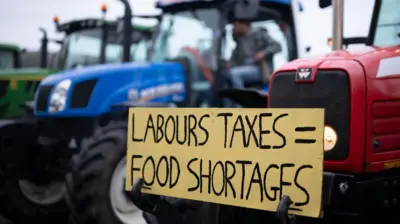We've updated our Privacy and Cookies Policy
We've made some important changes to our Privacy and Cookies Policy and we want you to know what this means for you and your data.
Why is India obsessed with monsoon rains?
Image source, Reuters
- Author, Soutik Biswas
- Role, India correspondent
This is possibly the only time of the year in India when over a billion people await an unusual bit of news with bated breath.
And so, this time the tidings are good and arrived over the weekend.
, announced a relieved Business Standard on Saturday. The newspaper said the southwest monsoon, "the lifeline for millions of farmers across the country" had hit the southern state on its "usual onset date".
Even Bollywood's biggest star Amitabh Bachchan joined the celebrations.
"The monsoons have reached Kerala and the Lakshdweep islands... This is a good sign... A week later, traditionally, they should be over Mumbai... This is an indicator of a normal monsoon. We survive and depend on this rain phenomena and much of India's produce depends on its performance - the monsoons I mean,"
Monsoon rains are serious business in India.
Editorials are written on it, weather experts talk about it on prime time news television, and people send up prayers when it's delayed. Weather insurance policies with built in rainfall insurance are sold to farmers as a hedge against uncertain weather.
A good monsoon leads to bountiful crop which raises farm incomes, boosts rural consumption and drives the economy. A weak monsoon - and droughts, in extreme cases - hurts farm workers, raises food prices, encourages hoarders and generally creates havoc in the economy.
As early as in 1925, the described the Indian economy as a gamble on the monsoon.
Some three decades later, in 1953, the prestigious The Economic Weekly in a simply titled The Monsoon bemoaned the lack of proper meteorological tools to forecast monsoons and said: "Had the annual rainfall meant as much in the economic life of Europe as it does in this country, it is a permissible guess that some measure would have been found for it ere long".
More than half a century later, the Business Standard reported over the weekend: "The rains, from June to September, are vital for the 55% of farmland without irrigation in India, one of the world's largest producers and consumers of food."
Consider the facts and you realise why over a billion people are obsessed with monsoon rains.
India's farms are mainly rain-fed. The country receives 75% of its yearly rainfall between June and September. Some 70% of Indians depend directly or indirectly on farming.
Farming accounts for 14.5% of India's $1.83 trillion GDP, and though its share is declining, agriculture still accounts for a whopping 58% of the total employment in the country.
And then there's the spectre of drought.
Some 68% of India, according to the , is prone to droughts in varying degrees - a third of this area is actually "chronically drought prone". Between 1801 and 2002, according to one estimate, India faced 42 severe droughts, many of them damaging crops and hurting growth.
To rely less on the vagaries of the monsoon rains, India, say experts, needs to develop varieties of rice, pulses and oilseeds which are drought resistant, evolve early drought warning systems and improve meteorological tools to provide sharper forecasts.
It also needs to ramp up its still scanty water conservation efforts. Too much water gets wasted. India also needs to manage its huge food stocks - over 60 million tonnes at the start of this year - much better. Too much food gets destroyed and damaged. That, many say, is a bigger tragedy than an imprecise monsoon forecast.
Top Stories
More to explore
Most read
Content is not available








